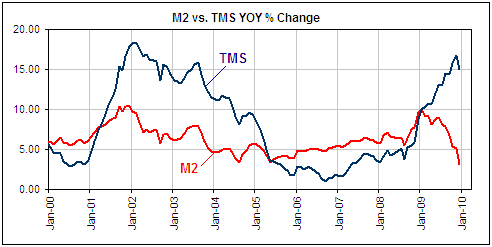Thoughts on Monetary Inflation
Steve Saville
email: sas888_hk@yahoo.com
Jan 12, 2010
Below is an excerpt from a commentary originally posted at www.speculative-investor.com on 10th January, 2010.
Inflation: A deliberate policy, not the natural way
The US Federal Reserve ("the Fed") was created in 1913. All the shares of the Fed are owned by private banks (every bank operating within the Federal Reserve system must have equity in the Fed), so it can be said that the Fed is privately owned. However, the shares held by the private banks confer almost none of the normal ownership privileges, and control of the Fed is almost completely within the hands of the US Government. It is therefore more accurate to consider the Fed a government agency -- an agency that operates for the benefit of the government and the banks.
The Fed's main achievement during its existence has been massive inflation of the US dollar supply, the bulk of which occurred after the loosening of the 'gold shackles' in 1934. And one of the most obvious effects of this monetary inflation has been a 95% decline in the dollar's purchasing power (one dollar today buys roughly what 5c bought in 1913). Furthermore, the loss of purchasing power has transpired in such a relentless fashion that almost everyone now perceives rising prices to be the natural way of things. Few people realise that during the 100-year period prior to the Fed's creation -- a period during which the US economy made exceptional progress -- the dollar lost none of its purchasing power.
The reality is that a long-term DOWNWARD trend in prices is the natural way of things in a FREE economy. In the absence of government manipulation of the money supply, prices will naturally fall over the long-term due to increasing productivity. This means that in the absence of government manipulation of the money supply there would be no need for a person to speculate in order to secure his/her financial future. A person could simply save cash, safe in the knowledge that the cash will buy at least as much in the future as it does in the present. In other words, monetary inflation forces everyone to become a speculator, an endeavour at which some will succeed and most will fail.
A few smart people are presently anticipating deflation. We certainly see the appeal of the deflation view given the present economy-wide debt burden, but, unfortunately, such a view flies in the face of both logic and history (the history of the past 75 years and the history of the past 15 months). We say "unfortunately" because a period of deflation is needed to establish the foundation for a sustainable economic expansion, whereas more inflation will only make a terrible situation even worse.
Rather than deflation, chances are that the US government, via its tool known as "the Fed", will continue to borrow and spend enough new money into existence to more than offset the private sector's desperate attempts to repair its collective balance sheet. In the process they will probably end up eradicating much of the remaining 5% of the dollar's purchasing power.
Money Supply Variations
Rarely in the past has the choice of monetary aggregate (TMS, M2, M3, etc.) been so important, because rarely have there been such large differences between the rates of change of the different money supply measures. For example, the following chart reveals a dramatic divergence over the past 12 months between the year-over-year (YOY) growth rates of M2 and TMS, such that we now have M2's YOY growth rate at a 10-year low at the same time as TMS's YOY growth rate is near a 10-year high. Moreover, some measures of US money supply -- most notably, the M3 calculation at http://www.nowandfutures.com/key_stats.html and Frank Shostak's AMS calculation -- currently show outright monetary deflation!

When TMS diverges markedly from M2 and M3 we can be confident that TMS reflects the true situation. The reason is that M2 and M3 have components that are not money, and when divergences occur they are caused by changes in the non-monetary components (Money-Market Mutual Funds and Time Deposits, primarily). The current situation contains an additional complication, though, because TMS has also diverged markedly from the Austrian Money Supply (AMS) calculation done by Frank Shostak. As discussed in the 21st December 2009 Weekly Update, this particular divergence is mostly due to the treatment of the US Treasury's Supplementary Financing Program (SFP). Specifically, Dr. Shostak's decision to treat the SFP account at the Fed as "money" distorted the year-over-year numbers in his AMS calculation by creating a huge upward spike in money-supply growth during September-November of 2008 and then a plunge in money-supply growth as the program was unwound during 2009.
The reason we are harping on this subject is that over the next few months you will very likely read articles in which money-supply charts are used to 'prove' that DEFLATION is occurring and other articles in which money-supply charts are used to highlight an INFLATION problem. It is important to understand how such contradictory conclusions could be drawn about something that should be straightforward.
###
Steve Saville
 email: sas888_hk@yahoo.com email: sas888_hk@yahoo.com
Hong Kong Regular financial market forecasts and analyses are provided at our web site:
http://www.speculative-investor.com/new/index.html. We aren't offering a free trial subscription at this time, but free samples of our work (excerpts from our regular commentaries) can be viewed at: http://tsi-blog.com
Copyright ©2002-2019 speculative-investor.com All Rights Reserved. Saville Archives
321gold Ltd

|

